Ixobrychus novaezelandiae Purdie, 1871
New Zealand (little) bittern, Black-backed bittern, Kaoriki (Māori)
Taxonomy & Nomenclature
A complete synonymy taken from (Checklist Committee (OSNZ), 2022:180):
Ardeola Novae Zelandiae Purdie, 1871 (Jan.): Proc. N.Z. Inst. (Otago) 3: 99 – Lake Wakatipu, Fiordland.; Ardetta pusilla Gould; Potts 1871, Trans. N.Z. Inst. 3: 97. Not Ardea pusilla Vieillot, 1817.; Ardea pusilla; Hutton 1871, Cat. Birds N.Z.: 27. Not Ardea pusilla Vieillot, 1817.; Ardetta maculata Latham; Buller 1874, Trans. Proc. N.Z. Inst. 6: 119, pl. 21. Not Ardea maculata Gmelin, 1789.; Ardea maculata Latham; Travers 1883, Trans. Proc. N.Z. Inst. 15: 187. Not Ardea maculata Gmelin, 1789.; Ixobrychus minutus novaezelandiae (Potts) [sic]; Mathews & Iredale 1913, Ibis 1 (10th series): 406.; Ixobrychus minutus novaezelandiae; Oliver 1930, New Zealand Birds, 1st edition: 367.; Dupetor flavicollis (Linnaeus) [sic]; Horn 1980, Notornis 27: 401. Not Ardea flavicollis Latham, 1790.; Ixobrychus novaezelandiae (Potts) [sic]; Checklist Committee 1990, Checklist Birds N.Z.: 93.
According to (Payne, 1979) Ixobrychus novaezelandiae is a senior synonym of I. minutus dubius.
Conservation Status
Extinct (WCMC, 1992:212)
Last record: before 9 August 1870 (Purdie, 1871); 1890's (Tennyson & Martinson, 2006); 1895 (Kittelberger et al., 2024); 1900 (WCMC, 1992:212)
IUCN RedList status: Extinct
Distribution
Chatham Islands & North Island (prehistoric) & South Island (historical), New Zealand
Biology & Ecology
Hypodigm
Holotype: MNZ OR.000644 (collected pre-1871)
Type locality: Lake Wakatipu
Media
The holotype (four photos):
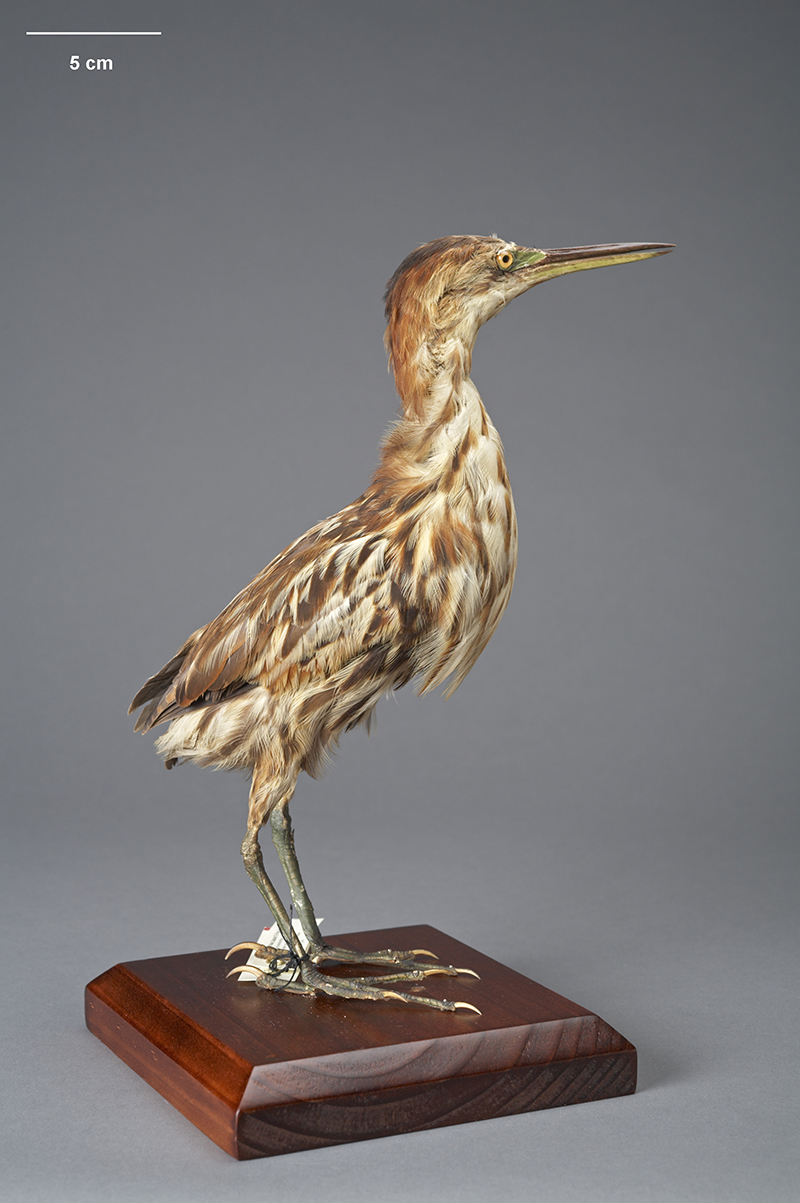
Above: New Zealand Little Bittern, Ixobrychus novaezelandiae, collected Head of Lake Wakatipu, New Zealand. Purchased 1907. CC BY 4.0. Te Papa (OR.000644)
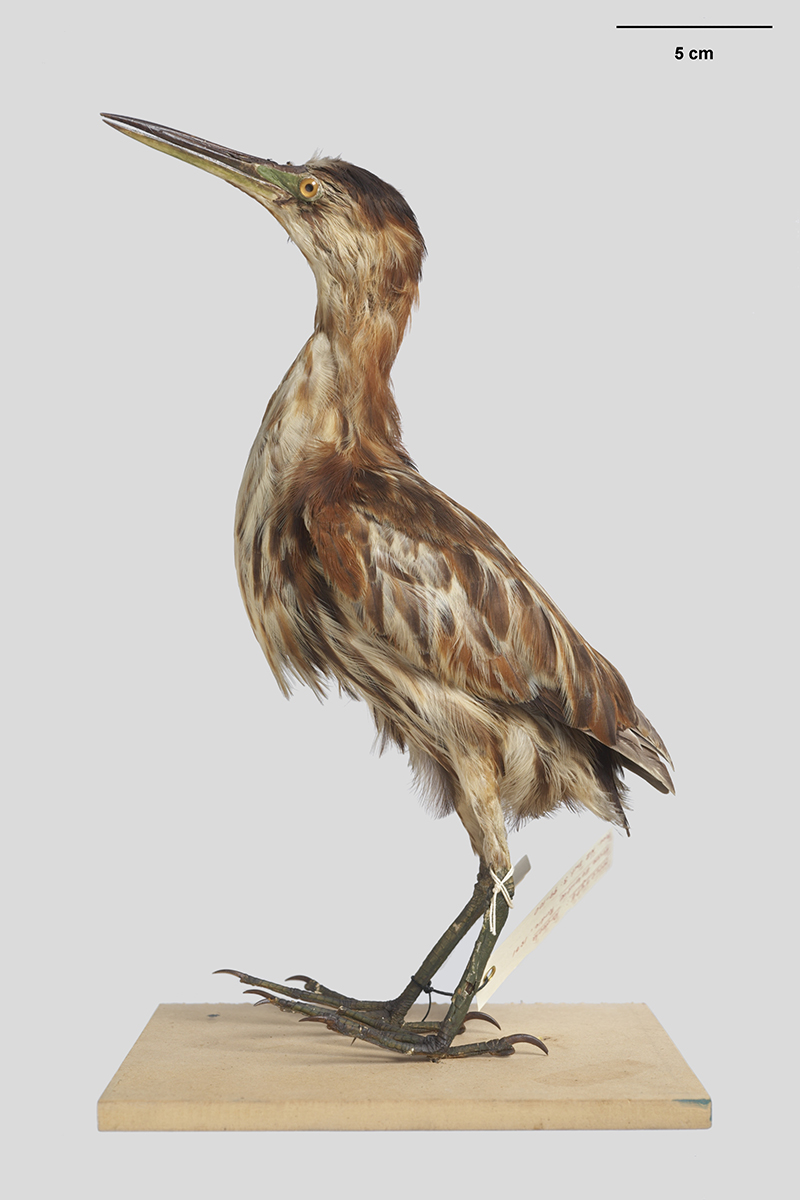
Above: New Zealand Little Bittern, Ixobrychus novaezelandiae, collected Head of Lake Wakatipu, New Zealand. Purchased 1907. CC BY 4.0. Te Papa (OR.000644)
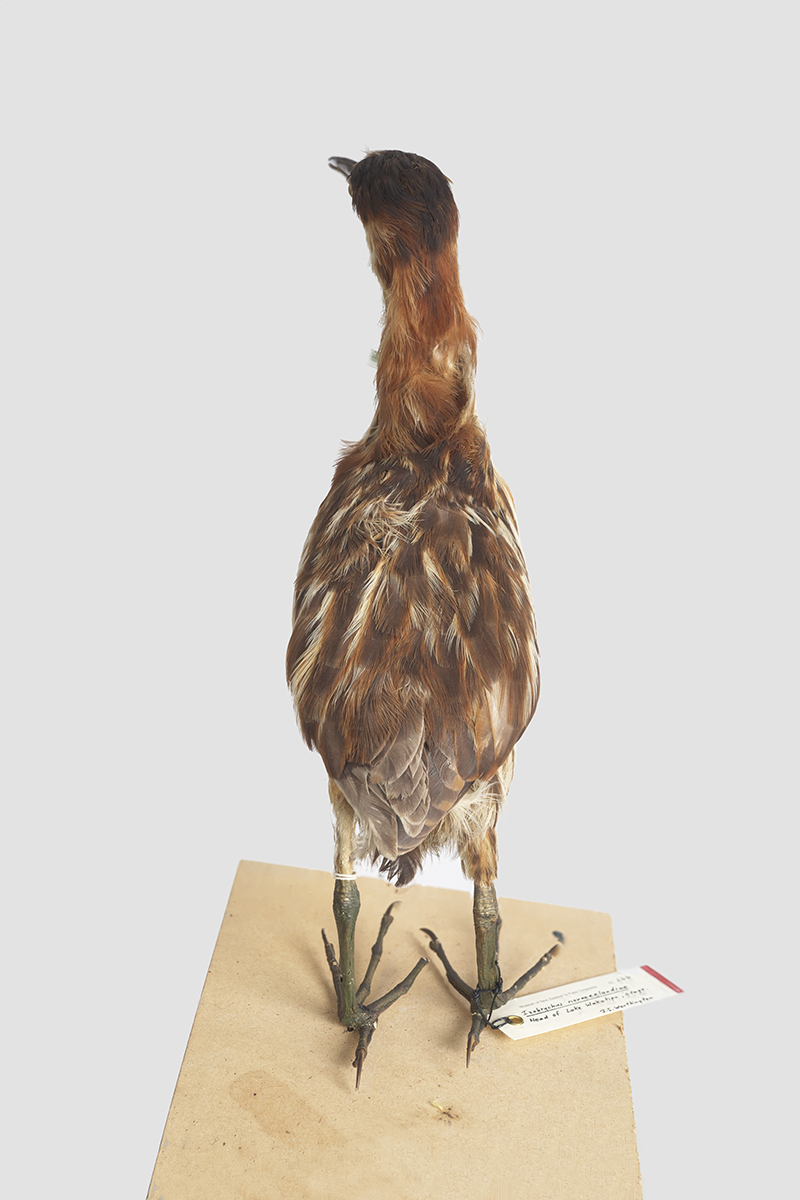
Above: New Zealand Little Bittern, Ixobrychus novaezelandiae, collected Head of Lake Wakatipu, New Zealand. Purchased 1907. CC BY 4.0. Te Papa (OR.000644)
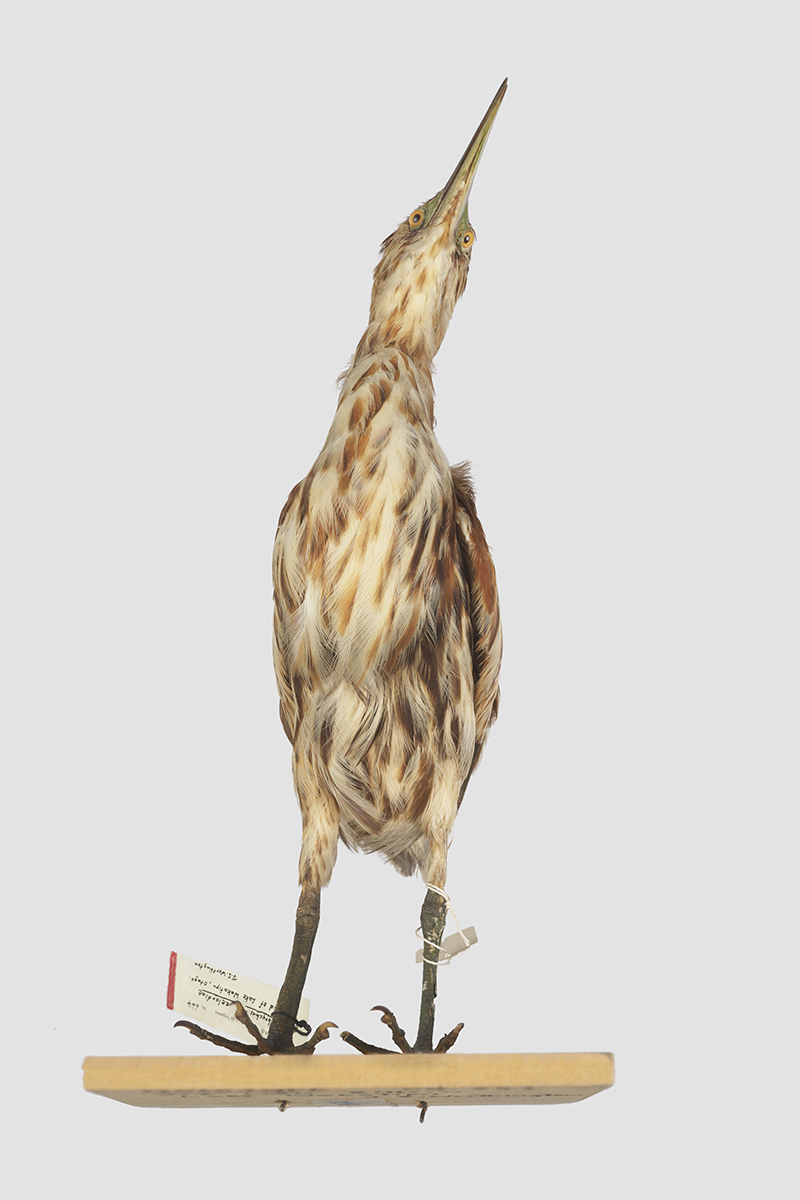
Above: New Zealand Little Bittern, Ixobrychus novaezelandiae, collected Head of Lake Wakatipu, New Zealand. Purchased 1907. CC BY 4.0. Te Papa (OR.000644)
Paintings
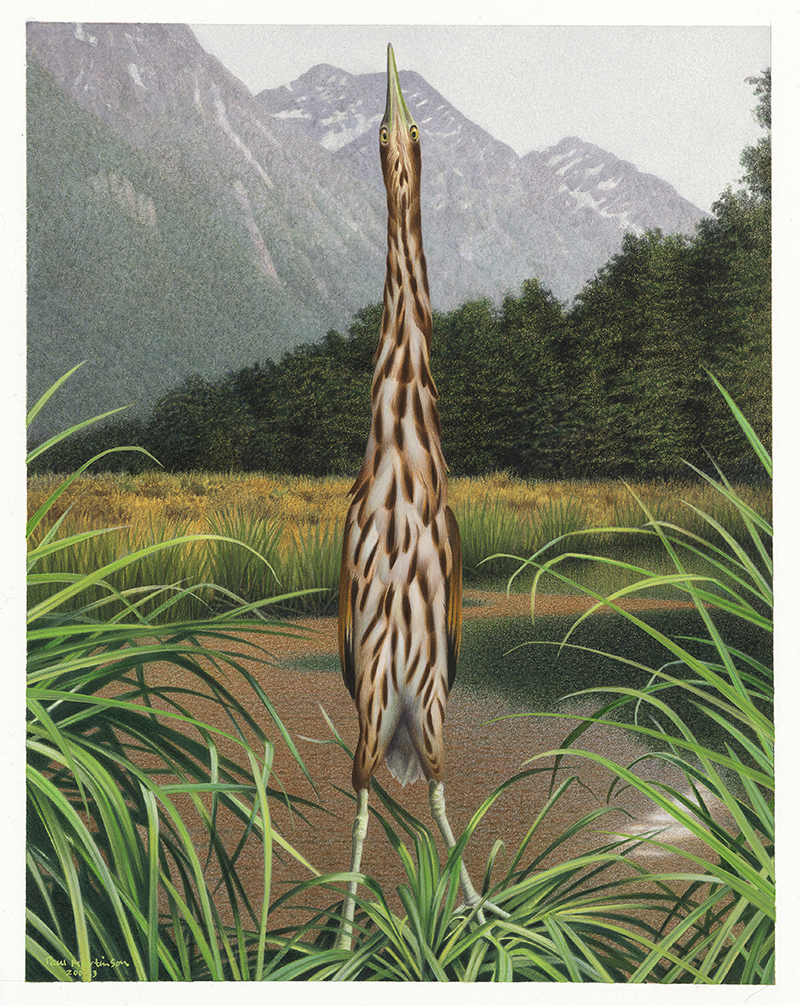
Above: New Zealand Little Bittern / Kaoriki. Ixobrychus novaezelandiae. From the series: Extinct Birds of New Zealand., 2003, Masterton, by Paul Martinson. Purchased 2006. © Te Papa. CC BY-NC-ND 4.0. Te Papa (2006-0010-1/26)
References
Original scientific description:
Purdie, A. C. (1871). On a (supposed) new species of Bittern from the Lake District. Proceedings of the New Zealand Institute 3: 99-100.
Other references:
BirdLife International. (2012). Ixobrychus novaezelandiae. In: IUCN 2013. IUCN Red List of Threatened Species. Version 2013.1. (http://www.iucnredlist.org). Downloaded on 25 August 2013.
BirdLife International. 2016. Ixobrychus novaezelandiae. The IUCN Red List of Threatened Species 2016: e.T22697307A93607264. https://dx.doi.org/10.2305/IUCN.UK.2016-3.RLTS.T22697307A93607264.en. Accessed on 19 June 2022.
Brooks, T. 2000. Extinct species. In: BirdLife International (ed.), Threatened Birds of the World, pp. 701-708. Lynx Edicions and BirdLife International, Barcelona and Cambridge, U.K.
Buller, W.L. 1878. Notes on the ornithology of New Zealand. Transactions and Proceedings of the New Zealand Institute 10: 191–201.
Buller, W.L. 1905–06. Supplement to the “Birds of New Zealand”. London: published by the author. Volume 1: xlix + 200 pp., 5 pls; Volume 2: iii + 178 pp., 7 pls.
Checklist Committee (OSNZ). (2010). Checklist of the Birds of New Zealand, Norfolk and Macquarie Islands, and the Ross Dependency, Antarctica (4th ed.). Ornithological Society of New Zealand & Te Papa Press, Wellington. [p. 165]
Checklist Committee (OSNZ). (2022). Checklist of the Birds of New Zealand (5th edition). Ornithological Society of New Zealand Occasional Publication No. 1. Wellington: Ornithological Society of New Zealand. [p. 180]
Colenso, W. 1844. Journal of a naturalist. London Journal of Botany 3: 1–62.
Colenso, W. 1845. Memoranda of an excursion, made in the Northern Island of New Zealand, in the summer of 1841–2; Intended as a contribution towards the ascertaining of the natural productions of the New Zealand Groupe; with particular reference to their botany. The Tasmanian Journal of Natural Science, Agriculture, Statistics, &c. 2: 241–308.
del Hoyo, J., Collar, N.J., Christie, D.A., Elliott, A. and Fishpool, L.D.C. 2014. HBW and BirdLife International Illustrated Checklist of the Birds of the World. Volume 1: Non-passerines. Lynx Edicions BirdLife International, Barcelona, Spain and Cambridge, UK.
Holdaway, Richard N. (1999). Introduced predators and avifaunal extinction in New Zealand. In: MacPhee, R.D.E. (ed.), Extinctions in near time: causes, contexts and consequences, pp. 189-238. Plenum Press, New York.
Holdaway, Richard N. and Worthy, Trevor H. (1997). A reappraisal of the late Quaternary fossil vertebrates of Pyramid Valley Swamp, North Canterbury, New Zealand. New Zealand Journal of Zoology 24: 69-121.
Holdaway, Richard N., Worthy, Trevor H. and Tennyson, Alan J. D. (2001). A working list of breeding bird species of the New Zealand region at first human contact. New Zealand Journal of Zoology 28: 119-187.
Horn, P. L. (1980). Probable occurrence of the black bittern, Dupetor flavicollis (Linnaeus), in New Zealand. Notornis 27: 401-403.
Horn, P. L. (1983). Subfossil avian remains from Poukawa, Hawke's Bay, and the first record of Oxyura australis (Blue-billed duck) from New Zealand. Journal of the Roval Society of New Zealand 13(1/2): 67-78.
Kittelberger, Kyle D., Tanner, Colby J., Buxton, Amy N., Prewett, Amira and Şekercioğlu, Çağan Hakkı. (2024). Correlates of avian extinction timing around the world since 1500 CE. Avian Research 15: 100213. https://doi.org/10.1016/j.avrs.2024.100213 [Supplementary data (List of 216 taxa)]
Millener, P.R. 1991. The Quaternary avifauna of New Zealand. Pp. 1317–1344. In: Vickers-Rich, P.; Monaghan, J.M.; Baird, R.F. & Rich, T.H. (Eds). Vertebrate palaeontology of Australasia. Melbourne: Pioneer Design Studio in co-operation with the Monash University Publications Committee. 1437 pp.
Millener, P. R. (1996). Extinct birds, pp. 113-120 In: Anonymous (ed.) The Chatham Islands: heritage and conservation. Christchurch, Canterbury University Press and New Zealand Department of Conservation. 136 pp.
Payne, R. B. (1979). Family Ardeidae, pp. 193-244. In: Mayr, Ernst and Cotterell, G. W. (eds.). Check-list of birds of the world. Museum of Comparative Zoology, Boston.
Potts, T. H. (1871). On the Birds of New Zealand (Part II). Transactions of the New Zealand Institute 3: 59-109.
Robertson, H. A., Baird, K. A., Elliott, G. P., Hitchmough, R. A., McArthur, N. J., Makan, T. D., Miskelly, Colin M., O’Donnell, C. F. J., Sagar, P. M., Scofield, R. P., Taylor, G. A. and Michel, P. (2021). Conservation status of birds in Aotearoa New Zealand, 2021. New Zealand Threat Classification Series 36. Department of Conservation, Wellington. 43 pp.
Hugh Robertson, John Dowding, Graeme Elliott, Rod Hitchmough, Colin Miskelly, Colin O’Donnell, Ralph Powlesland, Paul Sagar, Paul Scofield, Graeme Taylor. (2013). Conservation status of New Zealand birds, 2012. New Zealand Threat Classification Series 4. 22 pp.
Sayol, Ferran, Steinbauer, Manuel J., Blackburn, Tim M., Antonelli, Alexandre and Faurby, Søren. (2020). Anthropogenic extinctions conceal widespread evolution of flightlessness in birds. Science Advances 6(49): eabb6095. https://doi.org/10.1126/sciadv.abb6095 [Supplementary Material (Data File S1)]
Tennyson, Alan J. D. and Martinson, P. (2006). Extinct Birds of New Zealand. Te Papa Press, Wellington.
Turbott, E.G. 1990. Checklist of the Birds of New Zealand. Ornithological Society of New Zealand, Wellington.
Tyrberg, Tommy. (2009). Holocene avian extinctions, pp. 63-106. In: Turvey, Samuel T. (ed.). Holocene Extinctions. Oxford, UK & New York, USA: Oxford University Press. xii + 352 pp.
WCMC (World Conservation Monitoring Centre). (1992). Global Biodiversity: Status of the Earth's living resources. London: Chapman & Hall. xx + 594 pp.
Worthy, Trevor H. and Holdaway, Richard N. (2002). The Lost World of the Moa: Prehistoric Life of New Zealand. Bloomington, Indiana: Indiana University Press. xxxiii + 718 pp.
<< Back to the Pelecaniformes (Egrets, Herons, Ibises, Pelicans, Shoebills, etc.) database
